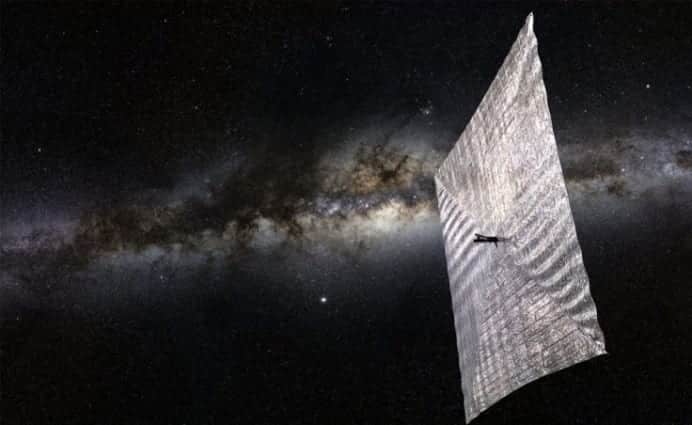Planetary Society is all set to launch Carl Sagan’s first Solar Sail powered spacecraft, on May 20th.
During one of his interviews on a 1976 broadcast of the Tonight Show with Johnny Carson, late science ambassador Carl Sagan had spoken about a small model which was made with tin foil that he showcased during the show; further he also believed it to be the future of the space travel. Sagan had then explained: “There’s just a tremendously exciting prospect called solar sailing. [It] travels on the radiation and particles that come out of the sun, the wind from the sun. Because it has a constant acceleration, it can get you around the inner part of the solar system a lot faster…than the usual sorts of rocket propulsion.”
Well, today Carl Sagan’s Planetary Society is in full swing to test a spacecraft which he had proposed way back in 1976. The Solar Sail powered spacecraft is known as Light Sail or Solar Sail or Photon Sail and it uses sunlight for propulsion. Though Light Sail has successfully passed the tests till now; its time that it is launched in the upper atmosphere of the Earth which would test the deployment capability of its huge “Mylar” sail in flight.
Some inputs regarding the Solar Sail Concept:
Some 400 years ago, Johannes Kepler was the first one to propose the idea of using sails for exploration of galaxies. He had observed that if comet tails are blown by some kind of solar breeze, the sails capture wind which can propel the spacecrafts much similar to the winds that move ships in ocean. Though Kepler’s idea was not accepted by astronomical society; however scientists later discovered that the energy from sunlight does exert force so as to move objects, thus now scientists across the globe are already engaged in experimenting to push Solar Sails into the space using light.
Solar Sail-powered spacecraft essentially require three components: A continuous force exerted by sunlight; Large ultra thin mirror; a separate launch vehicle.
Basically a Solar Sail powered spacecraft uses sunlight as its propellant and sun is its engine!! So that means one can save a lot on the rocket fuel if Solar Sail powered spacecraft works successfully. Solar sails somewhat fall into the same category as ion engine technology which means that though they have a lower thrust, but they are highly efficient.
Light is made up of electromagnetic radiation and though it does not have mass; however it does have a momentum which is able to exert a force on the objects that come in its contact. Further, when photons come in contact with the solar sail material, some of the energy is absorbed whereas the rest is reflected. It is this reflection that exerts some pressure on the sail which can push the spacecraft. It seems the effect of light on a smaller circumference is almost negligible hence Planetary Society researchers are using huge sheets of Mylar. Light Sail will be using 32 square meters of Mylar sail material.
It has been further discovered by the NASA researchers that a continuous force of sunlight on Solar Sail could result in to the propulsion of the spacecraft to a speed which is five times faster than the traditional rockets.
In addition to the huge Mylar sail material, Light Sail will also carry batteries, solar panels, communication systems, a computer and some flight hardware. All this fits into a tiny 3U CubeSat and Light Sail is a miniature satellite and which looks like a loaf of bread.
Solar Sail crafts have been previously launched by Japan and then US, however they both have launched smaller Solar Sails in past.
Planetary Society is a non profit founded by late Carl Sagan and now it is headed by Bill Nyle. A decade ago, in 2001, Planetary Society was the first one to attempt launching Solar Sail in space however the attempt was a failure as it was not able to separate from the final stage of a Russian rocket. A 30 minute sub orbital testing was carried out to check the technology of unfurling the panels in the Solar Sail, however the craft crashed in Kamchatka then.
The Linux powered Light Sail probe by Planetary Society is a miniature satellite and will not be able to get to other planets in the solar system however it is definitely a stepping stone towards that direction. For now, on May 20th, ‘Light Sail I’ will be launched only to the upper atmosphere where it needs to pass the test of deploying its huge Mylar sails in flight. Once it passes this test, the scientists at Planetary Society will move forward for their next mission which will put the Light Sail II in higher orbit to fully test the concept, which will probably begin next year in April 2016.
For now the big question faced by scientists is how to deploy something that huge in the space!! How the craft works in night is a question which I was trying to find out, may be the mirror will help which is one of the component required in the Light Sail. Readers can give their opinion on this as well.
Resource : NPR Blog
